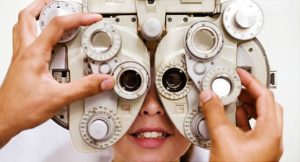March 1, 2022
By Dwight Akerman, OD, MBA, FAAO, FBCLA, FIACLE
 Determining the refractive status of children without cycloplegia is notoriously inaccurate due to their highly active accommodation. Therefore, cycloplegia is required to determine a child’s true refractive status.
Determining the refractive status of children without cycloplegia is notoriously inaccurate due to their highly active accommodation. Therefore, cycloplegia is required to determine a child’s true refractive status.
The three most commonly used cycloplegic agents include atropine, tropicamide, and cyclopentolate. The ideal cycloplegic agent is characterized by rapid onset, short duration of action, complete cycloplegia, and minimal side effects. Atropine is the gold standard for its cycloplegic effect, but the onset is very slow, and full recovery time is as long as 15 days. Therefore, it is not routinely used as a diagnostic agent in children or adults. Cyclopentolate is a synthetic antimuscarinic cycloplegic agent widely used as a cycloplegic agent in children and has been shown as effective as atropine at obtaining cycloplegia. For individuals with dark irises, cyclopentolate is characterized by an onset of quick action (30–45 min), a relatively short duration of action (24–48 h) with few side effects. Tropicamide, a synthetic analog of tropic acid, is another rapid-acting and safe agent for cycloplegic refraction. Compared with cyclopentolate, tropicamide is more acceptable in patients due to its fast onset (~30 min) and rapid recovery (6–7 h).
It has been reported that there is a delay in onset and a decrease in magnitude of cycloplegic effect with increased iris pigmentation in eyes caused by pigment binding of the cycloplegic agent. Therefore, researchers from China conducted a prospective randomized controlled study to evaluate the necessity of cycloplegia in Chinese young adults (aged 17–22 years) with dark irises and compare the cycloplegic effects of cyclopentolate and tropicamide. Although 0.5% tropicamide was utilized in this study, researchers confirmed that cyclopentolate had no statistically significant superiority in cycloplegia efficacy compared with tropicamide.
According to the International Myopia Institute Clinical Myopia Control Trials and Instrumentation Report, the recommended cycloplegia regimen that has been used in multiple clinical trials is two drops of 1% tropicamide separated by 5 minutes with primary outcome measures commencing 30 minutes after the first drop of tropicamide is instilled. Manny and colleagues have previously evaluated this protocol in an ethnically diverse cohort of U.S. children enrolled in the Correction of Myopia Evaluation Trial (COMET) and determined it to be an appropriate method for cycloplegia. Residual accommodation was found to be small (0.38 ± 0.41 D). Egashira et al. also compared the effects of cyclopentolate and tropicamide and found no meaningful difference in measured refractive error between agents 30 minutes after instillation. Given the unnecessarily longer-lasting cycloplegic and mydriatic effects of 1% cyclopentolate versus 1% tropicamide, as well as minimal additional gain in cycloplegia with cyclopentolate in myopic children, 1% tropicamide is recommended.
Abstract
A Randomized Clinical Trial Using Cyclopentolate and Tropicamide to Compare Cycloplegic Refraction in Chinese Young Adults with Dark Irises
Ruxia Pei, Zhuzhu Liu, Hua Rong, Liqiong Zhao, Bei Du, Na Jin, Hongmei Zhang, Biying Wang, Yi Pang, and Ruihua Wei
Background: To evaluate the necessity of cycloplegia for epidemiological studies of refraction in Chinese young adults (aged 17–22 years) with dark irises and compare the cycloplegic effects of 1% cyclopentolate and 0.5% tropicamide in them.
Methods: A total of 300 young adults (108 males and 192 females) aged 17 to 22 years (mean 19.03 ± 1.01) were recruited from Tianjin Medical University from November 2019 to January 2020. Participants were randomly divided into two groups. In the cyclopentolate group, two drops of 1% cyclopentolate eye drop were administrated (one drop every 5 min), followed by autorefraction and subjective refraction 30 to 45 min later. In the tropicamide group, four drops of 1% Mydrin P (Tropicamide 0.5%, phenylephrine HCl 0.5%) eye drop were given (one drop every 5 min), followed by autorefraction and subjective refraction 20 to 30 min later. The participants and the examiners were masked to the medication. Distance visual acuity, intraocular pressure (IOP), non-cycloplegic and cycloplegic autorefraction (Topcon KR-800, Topcon Co., Tokyo, Japan), non-cycloplegic and cycloplegic subjective refraction, and ocular biometry (Lenstar LS-900) were performed.
Results: The values of spherical equivalent (SE) and sphere component were significantly different before and after cycloplegia in the cyclopentolate group and the tropicamide group (p < 0.05). The mean difference between non cycloplegic and cycloplegic autorefraction SE was 0.39 D (±0.66 D) in the cyclopentolate group and 0.39 D (±0.34 D) in the tropicamide group. There was no significant difference in the SE and sphere component change after cycloplegia between the cyclopentolate group and the tropicamide group (p > 0.05). In each group, no significant difference was found between autorefraction and subjective refraction after cycloplegia (p > 0.05). We also found that more positive or less negative cycloplegic refraction was associated with the higher difference in SE in each group.
Conclusions: Cycloplegic refractions were generally more positive or less negative than non-cycloplegic refractions. It is necessary to perform cycloplegia for Chinese young adults with dark irises to obtain accurate refractive errors. We suggest that cycloplegic autorefraction using tropicamide may be considered as a reliable method for epidemiological studies of refraction in Chinese young adults with dark irises.
Pei, R., Liu, Z., Rong, H., Zhao, L., Du, B., Jin, N., … & Wei, R. (2021). A randomized clinical trial using cyclopentolate and tropicamide to compare cycloplegic refraction in Chinese young adults with dark irises. BMC ophthalmology, 21(1), 1-9.
DOI: https://doi.org/10.1186/s12886-021-02001-6













